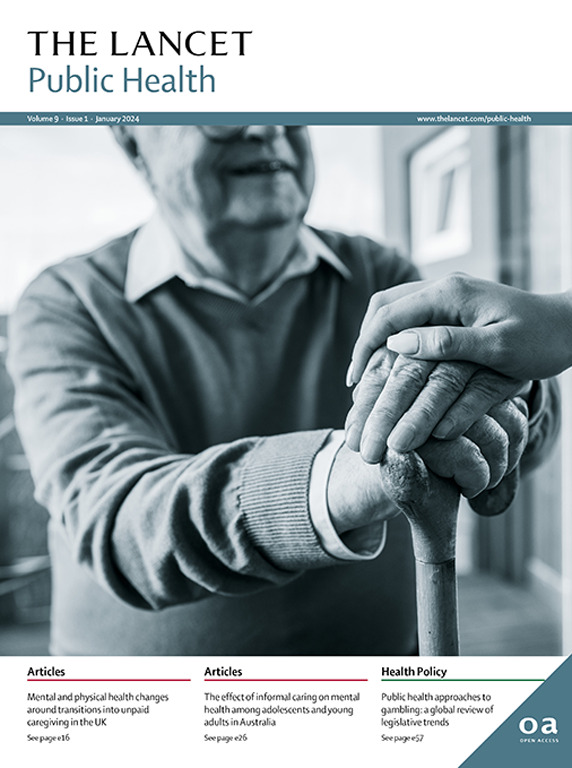消除烟草战略对 185 个国家肺癌死亡率的估计影响:基于人口的出生队列模拟研究
IF 25.4
1区 医学
Q1 PUBLIC, ENVIRONMENTAL & OCCUPATIONAL HEALTH
引用次数: 0
摘要
背景无烟一代旨在防止向特定年份后出生的人出售烟草。方法在这项基于人群的出生队列模拟研究中,我们提出了一种假设情景,即禁止向 2006 年 1 月 1 日至 2010 年 12 月 31 日期间出生的人出售烟草,并且完全执行这一干预措施,直至 2095 年 12 月 31 日。为了预测未来的肺癌死亡率,我们从世界卫生组织死亡率数据库中提取了至少有 15 年数据的国家按性别、5 岁年龄组和 5 年日历期划分的肺癌死亡率数据。对于没有死亡率数据的国家,我们从《五大洲癌症发病率》中提取了肺癌发病率数据。为了确定如果杜绝吸烟,出生队列中可避免的肺癌死亡人数,我们从出生队列中的预期肺癌死亡率中减去先前研究中报告的从未吸烟者(以下简称从未吸烟者)的特定年龄死亡率,并将这一差值应用于人口规模。我们用可预防的肺癌死亡人数除以出生队列中预期的肺癌死亡人数,计算出了人口影响分数(PIFs),即可以预防的肺癌死亡人数的百分比。我们还将预期死亡人数和可预防死亡人数按世界银行的四个收入组别(即高收入组、中上收入组、中低收入组和低收入组)进行了汇总。主要结果是实施无烟一代对肺癌死亡率的影响。在全球范围内,我们预测如果肺癌发病率继续保持过去 15 年的趋势,2006-10 年间出生的人群中可能会有 2 951 400 人死于肺癌。在这些死亡病例中,1 842 900 例(62-4%)预计发生在男性身上,1 108 500 例(37-6%)预计发生在女性身上。我们估计,如果能实现消除烟草(即无烟一代),2006-10 年间出生的 2 951 400 例肺癌死亡中的 1 186 500 例(40-2%)是可以避免的。我们估计,男性(1 842 900 例死亡中的 844 200 例[45-8%])比女性(1 108 500 例死亡中的 342 400 例[30-9%])可预防的肺癌死亡人数更多。在男性个体中,中欧和东欧的PIF最高(65 800例死亡中的48 900例[74-3%]),而在女性个体中,西欧的PIF最高(72 300例死亡中的56 200例[77-7%])。中部非洲是男性(8600 例死亡中的 180 例[2-1%])和女性(6400 例死亡中的 60 例[0-9%])PIF 最低的地区。在低收入国家的 128 900 例死亡中,男女合计的 PIF 为 17 400 例(13-5%);在中低收入国家的 662 800 例死亡中,男女合计的 PIF 为 104 900 例(15-8%);在中高收入国家的 1 482 200 例死亡中,男女合计的 PIF 为 650 100 例(43-9%);在高收入国家的 677 600 例死亡中,男女合计的 PIF 为 414 100 例(61-1%)。然而,低收入国家的数据很少,因此在解释我们的估计值时应谨慎。本文章由计算机程序翻译,如有差异,请以英文原文为准。
Estimated impact of a tobacco-elimination strategy on lung-cancer mortality in 185 countries: a population-based birth-cohort simulation study
Background
The tobacco-free generation aims to prevent the sale of tobacco to people born after a specific year. We aimed to estimate the impact of eliminating tobacco smoking on lung-cancer mortality in people born during 2006–10 in 185 countries.Methods
For this population-based birth-cohort simulation study, we proposed a scenario in which tobacco sales were banned for people born between Jan 1, 2006, and Dec 31, 2010, and in which this intervention was perfectly enforced, quantified until Dec 31, 2095. To predict future lung-cancer mortality rates, we extracted lung-cancer mortality data by sex, 5-year age group, and 5-year calendar period for countries with at least 15 years of data from the WHO Mortality Database. For countries for which mortality data were not available, we extracted data on lung-cancer incidence from the Cancer Incidence in Five Continents. To establish the number of lung-cancer deaths that could be prevented in the birth cohort if tobacco smoking was eliminated, we subtracted reported age-specific rate of deaths in people who had never smoked tobacco (hereafter referred to as never smokers) from a previous study from the expected rate of lung-cancer deaths in our birth cohort and applied this difference to the size of the population. We computed population impact fractions (PIFs), the percentage of lung-cancer deaths that could be prevented, by dividing the number of preventable lung-cancer deaths by the expected lung-cancer deaths in the birth cohort. We also aggregated expected and prevented deaths into the four World Bank income groups (ie, high-income, upper-middle-income, lower-middle-income, and low-income). The primary outcome was the impact on lung-cancer mortality of implementing a tobacco-free generation.Findings
Our birth cohort included a total population of 650 525 800 people. Globally, we predicted that 2 951 400 lung-cancer deaths could occur in the population born during 2006–10 if lung-cancer rates continue to follow trends observed during the past 15 years. Of these deaths, 1 842 900 (62·4%) were predicted to occur in male individuals and 1 108 500 (37·6%) were expected to occur in female individuals. We estimated that 1 186 500 (40·2%) of 2 951 400 lung-cancer deaths in people born during 2006–10 could be prevented if tobacco elimination (ie, a tobacco-free generation) was achieved. We estimated that more lung-cancer deaths could be prevented in male individuals (844 200 [45·8%] of 1 842 900 deaths) than in female individuals (342 400 [30·9%] of 1 108 500 deaths). In male individuals, central and eastern Europe had the highest PIF (48 900 [74·3%] of 65 800 deaths) whereas in female individuals, western Europe had the highest PIF (56 200 [77·7%] of 72 300 deaths). Middle Africa was the region with the lowest PIF in both male individuals (180 [2·1%] of 8600 deaths) and female individuals (60 [0·9%] of 6400 deaths). In both sexes combined, PIF was 17 400 (13·5%) of 128 900 deaths in low-income countries, 104 900 (15·8%) of 662 800 deaths in lower-middle-income countries, 650 100 (43·9%) of 1 482 200 deaths in upper-middle-income countries, and 414 100 (61·1%) of 677 600 deaths in high-income countries.Interpretation
The implementation of a tobacco-free generation could substantially reduce global lung-cancer mortality. However, data from low-income countries were scarce and our estimates should be interpreted with caution.Funding
Spanish Society of Pneumology and Thoracic Surgery.求助全文
通过发布文献求助,成功后即可免费获取论文全文。
去求助
来源期刊

Lancet Public Health
Medicine-Public Health, Environmental and Occupational Health
CiteScore
55.60
自引率
0.80%
发文量
305
审稿时长
8 weeks
期刊介绍:
The Lancet Public Health is committed to tackling the most pressing issues across all aspects of public health. We have a strong commitment to using science to improve health equity and social justice. In line with the values and vision of The Lancet, we take a broad and inclusive approach to public health and are interested in interdisciplinary research.
We publish a range of content types that can advance public health policies and outcomes. These include Articles, Review, Comment, and Correspondence. Learn more about the types of papers we publish.
 求助内容:
求助内容: 应助结果提醒方式:
应助结果提醒方式:


